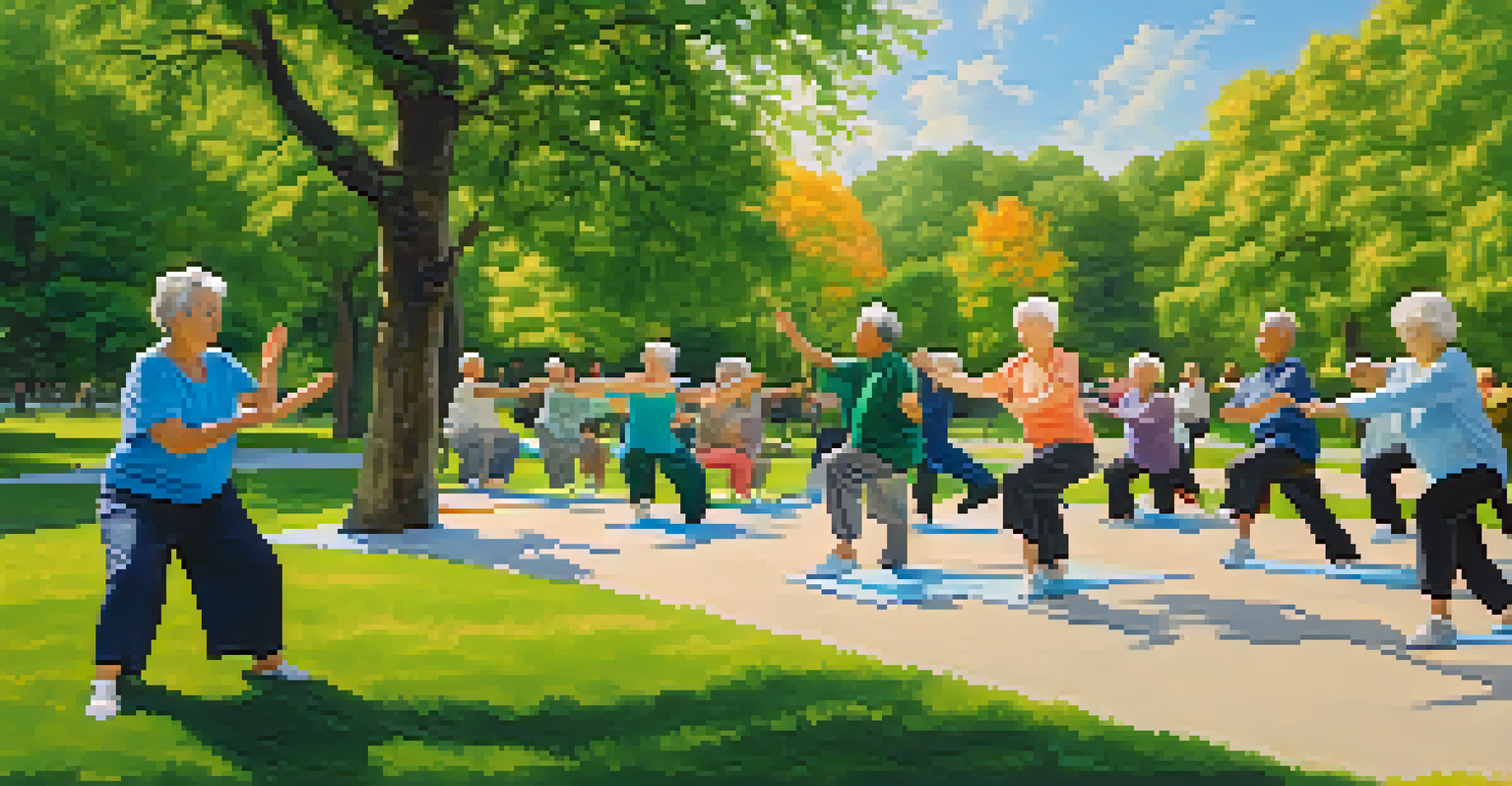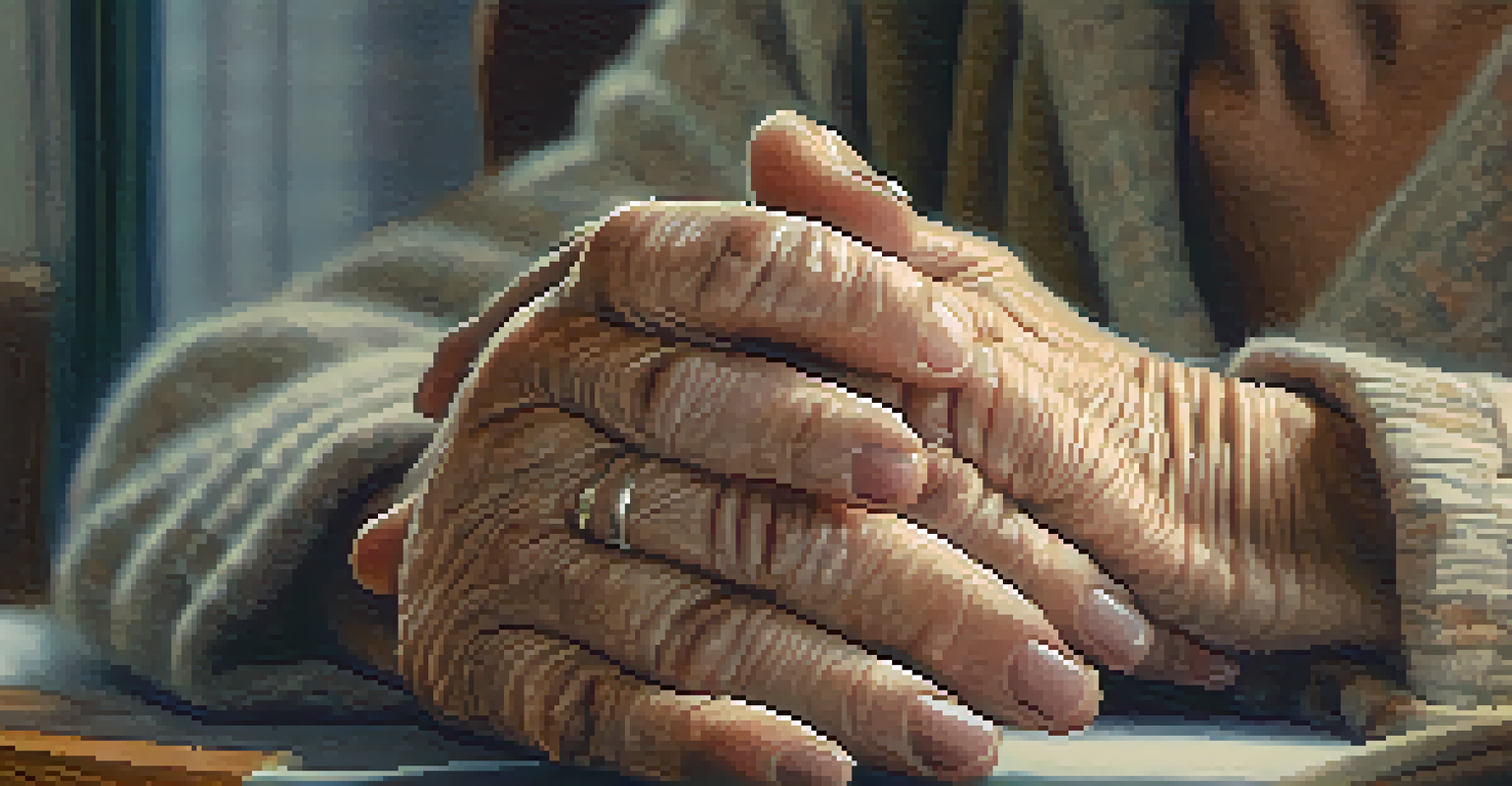The Role of Breathing Techniques in Senior Fitness

Understanding Breathing Techniques for Seniors
Breathing techniques are simple yet powerful exercises that can significantly impact fitness, especially for seniors. These methods focus on controlling the breath, which can enhance both physical and mental well-being. By learning to breathe correctly, older adults can improve oxygen flow and reduce stress, making workouts more effective and enjoyable.
Breath is the bridge which connects life to consciousness, which unites your body to your thoughts.
For instance, deep belly breathing, where one inhales deeply through the nose and exhales through the mouth, helps to engage the diaphragm fully. This technique not only calms the mind but also prepares the body for physical activity. Consequently, seniors can experience enhanced energy levels and improved resilience during their fitness routines.
Moreover, incorporating breathing techniques into daily routines can also promote better posture and stability. As seniors adopt these practices, they often find themselves more aware of their bodies, which can lead to safer and more confident movements during exercise.
Benefits of Breathing Techniques in Senior Fitness
One of the most notable benefits of breathing techniques is their ability to reduce anxiety and enhance relaxation. For many seniors, the thought of exercising can be daunting, but focused breathing can help calm nerves and make physical activity feel more approachable. By fostering a sense of calm, seniors are more likely to stick with their fitness routines.

Additionally, proper breathing techniques can improve endurance and stamina. When seniors practice deep and controlled breathing, they increase oxygen delivery to their muscles. This improved oxygenation can lead to longer, more effective workouts, making it easier to engage in various activities, from walking to yoga.
Breathing Boosts Senior Fitness
Incorporating breathing techniques can enhance physical performance and make workouts more enjoyable for seniors.
Moreover, these techniques can play a critical role in recovery. After exercising, seniors can use breathing practices to help their bodies relax and recuperate. This focus on recovery is essential for maintaining long-term fitness and overall health.
Integrating Breathing Techniques into Workouts
Incorporating breathing techniques into fitness routines can be done seamlessly with little effort. One effective method is to align breath with movement, such as inhaling during a stretch and exhaling when returning to a resting position. This synchronization enhances both the effectiveness of the exercise and the overall experience.
The breath is the first and last thing we do in life, and it is the most important thing we can do for our health and well-being.
Seniors can also benefit from mindfulness practices that include breathing exercises. Activities like tai chi or gentle yoga often emphasize breath control, making them ideal for older adults looking to improve their fitness levels while also cultivating mindfulness. These practices foster a holistic approach to fitness.
It's essential for seniors to start slowly, focusing on their breath before adding more complex movements. By doing so, they can build a solid foundation that enhances their overall physical capabilities and confidence in their abilities.
Breathing Techniques for Balancing Fitness and Relaxation
Striking a balance between fitness and relaxation is crucial for seniors. Breathing techniques can serve as a bridge, helping to transition between high-energy workouts and calming practices. For example, after an intense cardio session, a few minutes of deep breathing can help lower heart rates and promote recovery.
Learning to incorporate relaxation breathing techniques, such as the 4-7-8 method—where one inhales for 4 seconds, holds for 7, and exhales for 8—can be particularly beneficial. This method not only helps to calm the nervous system but also encourages mindfulness and presence, which can enhance the overall workout experience.
Breathing Reduces Anxiety for Seniors
Focused breathing can help calm nerves, making exercise feel more approachable and increasing adherence to fitness routines.
Ultimately, by integrating relaxation through breathing with fitness activities, seniors can foster a healthier lifestyle that prioritizes both physical and mental well-being. This balance is essential for maintaining motivation and enjoyment in their fitness journeys.
Common Breathing Techniques for Seniors
Several breathing techniques are particularly effective for seniors. Diaphragmatic breathing, or deep belly breathing, encourages fuller inhalation and exhalation, promoting relaxation and reducing stress. This technique is easy to learn and can be practiced anywhere, making it a great addition to any fitness routine.
Another beneficial method is pursed-lip breathing, which involves inhaling through the nose and exhaling slowly through pursed lips. This technique can help control breath and improve lung function, especially beneficial for seniors who may have respiratory concerns. It’s a simple way to enhance endurance during workouts.
Lastly, box breathing—where one inhales, holds, exhales, and holds again for equal counts—can be excellent for calming the mind and enhancing focus. This method can be particularly helpful before or after workouts to center oneself and prepare for physical activity.
Safety Considerations When Practicing Breathing Techniques
While breathing techniques are generally safe, seniors should always consider their individual health conditions before starting any new practice. Consulting with a healthcare provider can provide personalized guidance, especially for those with respiratory or cardiovascular issues. Understanding one's limits is key to safe practice.
It's also important to practice these techniques in a comfortable setting. Seniors should ensure they are well-supported, whether seated or standing, to prevent any strain or discomfort. Starting with just a few minutes of practice can help them get accustomed to these techniques without feeling overwhelmed.
Safety First in Breathing Practices
Seniors should consult healthcare providers before starting new breathing techniques to ensure safety and accommodate health conditions.
Lastly, if a senior feels lightheaded or uncomfortable while practicing any breathing technique, they should stop immediately and consult a professional. Listening to one’s body is crucial, and adapting practices to suit individual needs will lead to the best outcomes.
Conclusion: Embracing Breathing for Better Senior Fitness
In conclusion, integrating breathing techniques into senior fitness programs can lead to a more enjoyable and effective exercise experience. These practices not only enhance physical performance but also promote relaxation and mental clarity. By prioritizing breathing, seniors can create a holistic fitness routine that caters to both body and mind.
Moreover, the benefits of these techniques extend beyond just workouts; they can improve overall quality of life. As seniors learn to breathe better, they may find themselves experiencing less stress and more joy in their daily activities, fostering a positive outlook on aging.

Ultimately, embracing breathing techniques is a simple yet transformative step toward achieving optimal health and wellness in senior years. With dedication and practice, seniors can unlock new levels of fitness and well-being, ensuring that they remain active and vibrant for years to come.